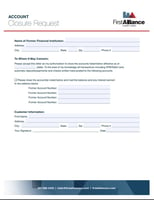The Most Common Mistakes When Switching Financial Institutions
Even though switching financial institutions is nowhere near as difficult as most people believe, the process isn’t foolproof. People can make...
2 min read
![]() First Alliance Credit Union
:
Jan 3, 2019 6:46:00 AM
First Alliance Credit Union
:
Jan 3, 2019 6:46:00 AM

For many people, the thought of switching to a new bank or credit union is intimidating, filled with several bureaucratic hoops to jump through and disastrous consequences if any of those hoops are missed. The truth is that switching bank accounts isn't as bad as it seems. Here's what you have to do to make the process as painless as possible.

Remember, not all automatic payments that you have previously established occur on a monthly basis. For example, insurance payments, some utilities and federal and state tax returns/payments can occur on irregular intervals such as bi-monthly, quarterly or even an annual basis.
 Confirm that all checks have cleared and all automatic payments have been transferred to your new account. Leave sufficient funds in your former account to cover any outstanding checks or pending automatic payments.
Confirm that all checks have cleared and all automatic payments have been transferred to your new account. Leave sufficient funds in your former account to cover any outstanding checks or pending automatic payments.I know it seems like a lot now, but once you start the process of switching accounts you will see that its not as painful as you think. Remember, your new financial institution should be so happy to have you that they will do everything they can to make the process smooth for you. If you'd like more information, check out our guide to switching financial institutions today.

Even though switching financial institutions is nowhere near as difficult as most people believe, the process isn’t foolproof. People can make...

If you’re considering switching to a new financial institution, you might wonder how does switching banks or credit unions affect your credit score?...

If you’re thinking about switching to a new bank or credit union, you might have come across some financial institutions offering something called a...